You may also like:
The 2025 BMW M2 delivers 473 horsepower from its twin-turbocharged inline-six engine with your choice of 6-speed manual or 8-speed automatic transmission for $66,675[1][2]. This represents a 20-horsepower increase over 2024, along with updated iDrive 8.5 technology and expanded color options including Sao Paulo Yellow and Vegas Red. The M2’s significance extends beyond specifications—it’s likely the last manual transmission M car BMW will produce, making it historically important for enthusiast collectors[3].
According to Autvex automotive experts, the 2025 M2 represents a precious moment in automotive history. As manufacturers universally abandon manual gearboxes in favor of faster automatics, the M2 stands as BMW M division’s final offering with three pedals—creating urgency among purists seeking authentic driving engagement before this option disappears forever.
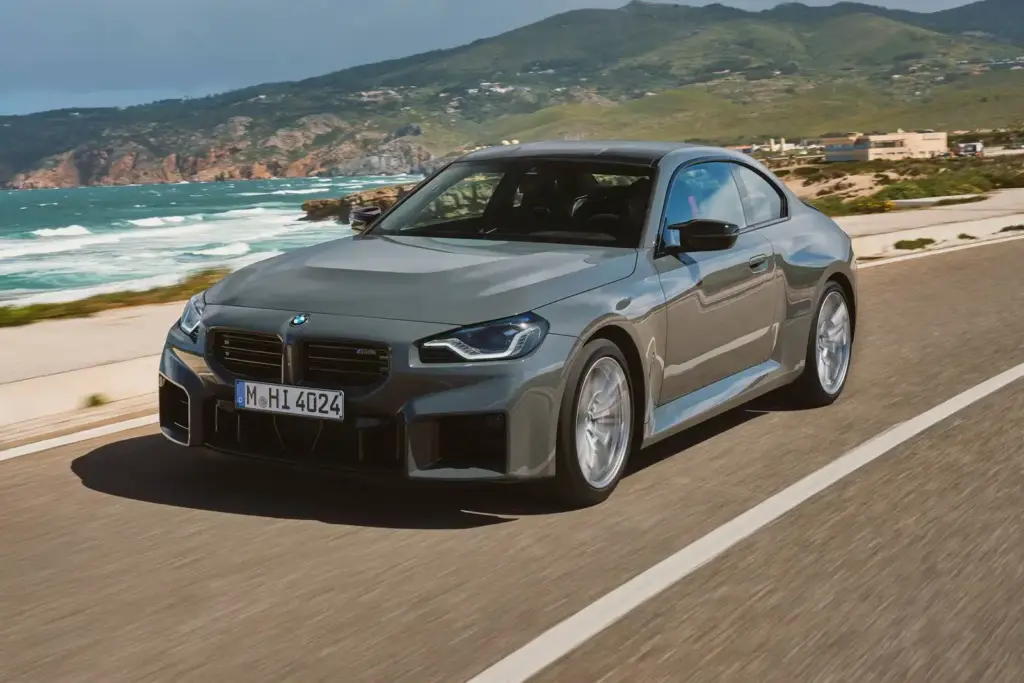
What’s New for the 2025 BMW M2
Power Increase and Performance Updates
BMW engineers extracted additional performance from the proven S58 engine for 2025, delivering measurable improvements in acceleration and throttle response[1][2].
2025 performance enhancements:
- Power increase: 473 hp (up 20 hp from 453 hp in 2024)
- Torque specifications: 406 lb-ft manual transmission / 442 lb-ft automatic
- 0-60 mph acceleration: 3.9 seconds automatic, 4.1 seconds manual
- Quarter-mile: 11.8 seconds @ 120 mph automatic, 12.2 seconds @ 117 mph manual
- Enhanced calibration: Improved throttle response across all drive modes
- Refined exhaust: Updated sound tuning for more aggressive note[1][2]
The torque differential between transmissions reflects engineering constraints. The automatic’s torque converter handles higher loads than the manual’s clutch and gearbox internals. BMW prioritizes transmission longevity over absolute parity, sacrificing 36 lb-ft in manual configurations to prevent premature wear during aggressive driving[2].
Technology and Interior Upgrades
The 2025 model year brings meaningful technology improvements enhancing daily usability and interface responsiveness[1].
Technology updates for 2025:
- iDrive 8.5: Updated operating system with improved response speed
- New steering wheel: Leather flat-bottom design with red center marker stripe
- M Carbon bucket seats: Now available as standalone option (previously Carbon Package only)
- Display graphics: Refreshed digital instrument cluster and infotainment visuals
- Voice control: Enhanced BMW Intelligent Personal Assistant natural language processing
- Connectivity: Improved wireless Apple CarPlay and Android Auto integration[1]
The M Carbon bucket seats represent significant upgrade for track enthusiasts. These lightweight seats provide exceptional lateral support during aggressive cornering while reducing overall vehicle weight. Previously bundled exclusively within the $9,900 Carbon Package, standalone availability allows buyers to prioritize seating without committing to the full carbon fiber roof and trim package[1].
Expanded Color and Customization Options
BMW broadened M2 personalization choices for 2025, introducing vibrant new colors and flexible option packaging[1].
New color offerings:
- Sao Paulo Yellow: Bright, attention-grabbing yellow finish
- Vegas Red: Deep metallic red with pearl effect
- Portimao Blue: Returning favorite M-specific blue
- Skyscraper Grey: Sophisticated metallic grey
- BMW Individual finishes: Frozen Pure Grey, Java Green, Voodoo Blue, Twilight Purple Pearl Effect
- Pricing stability: Base MSRP remains competitive at $66,675 including destination[1]
Color choice significantly impacts long-term value retention. Popular M-specific colors like Portimao Blue and Isle of Man Green historically command premiums in used markets, while uncommon Individual finishes appeal to niche buyers but may limit resale audience. The 2026 BMW M2 introduces the M2 CS variant with exclusive color options and performance upgrades[1].
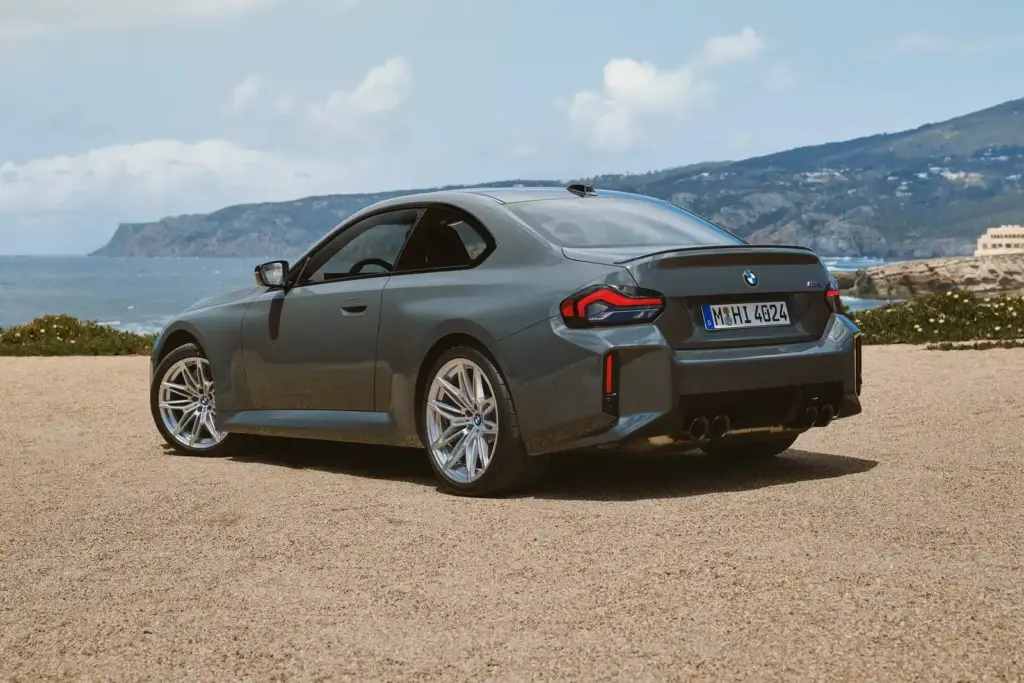
2025 BMW M2 Performance and Engine
S58 Twin-Turbo Inline-Six Engine
The S58 represents BMW’s latest evolution in performance inline-six engineering, sharing architecture with M3 and M4 models while receiving M2-specific calibration[2][4].
S58 engine specifications:
- Displacement: 3.0 liters (2,993 cc)
- Configuration: Inline-six with twin-scroll turbochargers
- Power output: 473 horsepower @ 6,250 rpm
- Torque: 406 lb-ft (manual) / 442 lb-ft (automatic) @ 2,650-6,130 rpm
- Engine design: Closed-deck block for structural strength
- Redline: 7,200 rpm
- Compression ratio: 9.3:1 (low for boost pressure tolerance)[2][4]
The closed-deck S58 design provides significant durability advantages over previous open-deck BMW turbo engines. This architecture reinforces cylinder walls, preventing head gasket failures that plagued earlier N54 and N55 engines. Combined with forged internals and conservative compression ratio, the S58 handles sustained high-performance use without reliability concerns affecting predecessors[4].
Acceleration and Real-World Performance
The M2’s power-to-weight ratio delivers impressive straight-line acceleration competitive with vehicles costing significantly more[1][2].
| Metric | Automatic | Manual |
|---|---|---|
| 0-60 mph | 3.9 seconds | 4.1 seconds |
| 0-100 mph | 8.7 seconds (est.) | 9.2 seconds (est.) |
| Quarter-mile | 11.8 sec @ 120 mph | 12.2 sec @ 117 mph |
| Top speed (standard) | 155 mph (limited) | 155 mph (limited) |
| Top speed (M Driver’s Pkg) | 177 mph | 177 mph |
| Launch control | Yes | Yes |
Real-world performance exceeds official figures in optimal conditions. Multiple independent tests recorded automatic M2s achieving 0-60 mph in 3.7-3.8 seconds with proper launch technique. The manual transmission’s slower acceleration matters less than the engagement it provides—rowing through gears creates visceral connection automatics cannot replicate[1][2].
Manual vs. Automatic Transmission Choice
The transmission decision represents philosophical choice as much as practical consideration[3][5].
Transmission comparison:
Manual transmission (6-speed)
- Purist appeal with three-pedal engagement
- 406 lb-ft torque (lower than automatic)
- Rev-matching downshift assistant available
- 54 lbs lighter than automatic
- No-cost option ($1,175 savings)
- Potential collector premium in future
- More involving driving experience
Automatic transmission (8-speed)
- Faster acceleration (0.4 seconds quicker)
- 442 lb-ft torque advantage
- Smoother shifts and better track consistency
- Adaptive cruise control compatibility
- Easier traffic and daily commute usability
- More advanced features integration
The manual M2 holds historical significance as likely the last three-pedal M car. BMW executives confirmed manual availability continues only while demand justifies production costs. With 90% of M2 buyers outside North America choosing automatics, and U.S. market manual adoption around 20-30%, this option faces uncertain future beyond current generation[3][5].
Handling and Driving Dynamics
The M2’s compact dimensions and chassis balance create agile handling characteristics distinct from larger M3/M4 models[4][6].
Dynamics highlights:
- Weight distribution: Perfect 50:50 front/rear balance
- Drivetrain: Rear-wheel drive with Active M Differential
- Wheelbase: 108.1 inches (compact for nimble handling)
- Track width: 62.2 inches front / 63.6 inches rear
- Curb weight: ~3,800 lbs manual / ~3,854 lbs automatic
- Drive modes: Comfort, Sport, Sport Plus with independent parameter adjustment
- Adaptive dampers: Three-stage electronically controlled suspension[4][6]
Reviewers consistently praise the M2’s tenacious grip and confidence-inspiring cornering capability. The wide 275mm front and 285mm rear Michelin Pilot Sport 4S tires provide exceptional traction, allowing aggressive throttle application mid-corner without overwhelming the rear axle. However, steering feel remains a common criticism—the speed-sensitive variable-ratio electric power steering lacks the feedback enthusiasts desire, requiring trust in the chassis rather than tactile communication[4][6].
Fuel Economy and Daily Usability
Performance and efficiency balance reasonably for a 473-horsepower sports coupe[1].
Fuel consumption and costs:
- EPA city: 16 mpg
- EPA highway: 23 mpg
- EPA combined: 19 mpg
- Real-world highway: 25-27 mpg achievable during steady cruising
- Fuel requirement: Premium 91+ octane unleaded
- Tank capacity: 13.5 gallons (52 liters)
- Range: ~257 miles combined / ~310 miles highway
- Annual fuel cost: $2,900 (15,000 miles @ $4.50/gallon premium)[1]
Daily usability exceeds expectations for hardcore performance coupe. The Comfort drive mode softens suspension dampers and throttle response, creating surprisingly civilized highway cruiser. Road noise remains noticeable with wide performance tires, though interior insulation adequately dampens wind and mechanical sounds. The firm ride quality at low speeds draws consistent criticism—expansion joints and rough pavement transmit harshness into the cabin despite adaptive dampers[4][6].
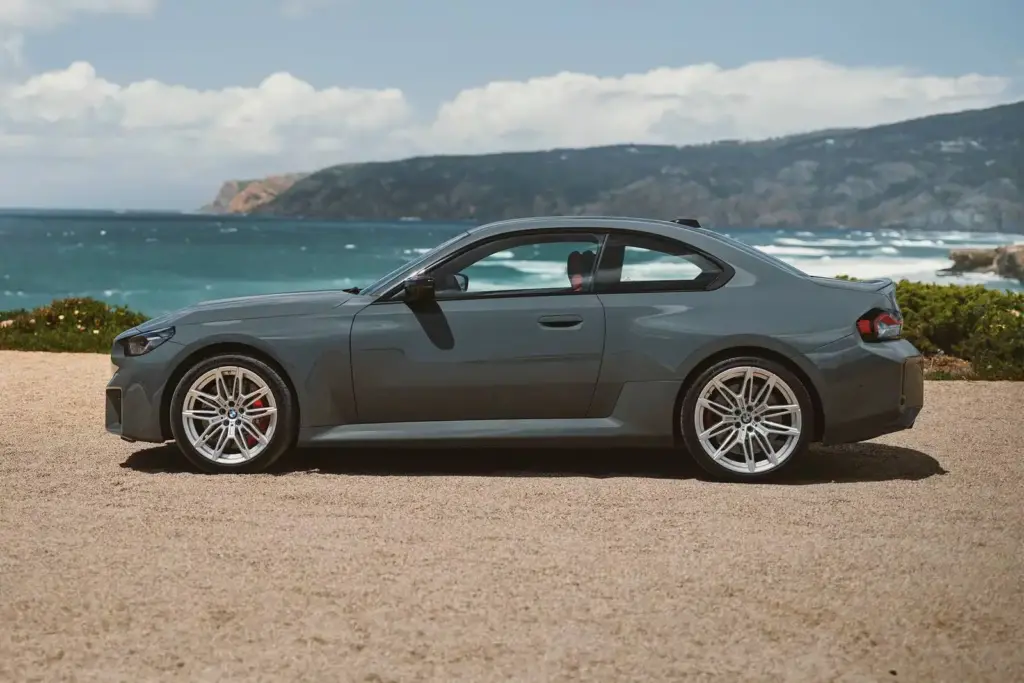
2025 BMW M2 Design and Styling
Exterior Design Philosophy
The G87 M2 maintains BMW M division’s muscular aesthetic while avoiding the controversial vertical kidney grilles characterizing current M3/M4 models[1].
Design characteristics:
- Overall length: 179.4 inches (4,557 mm)
- Width: 74.3 inches (1,887 mm) including mirrors
- Height: 55.2 inches (1,403 mm)
- Wheelbase: 108.1 inches (2,747 mm)
- Design language: Wide-body appearance with flared fenders
- Front fascia: Horizontal kidney grilles with M-specific mesh
- Quad exhausts: Signature M car rear styling element[1]
The M2’s proportions create visual tension—wide track and aggressive fenders on compact wheelbase. This “pint-sized aggression” divides opinions, with enthusiasts either embracing the muscular stance or finding it overwrought. Unlike the G80 M3’s polarizing vertical grilles that sparked widespread criticism, the M2’s horizontal orientation receives more favorable reception while maintaining unmistakable M identity[1].
Controversial Styling Elements
Automotive design inherently generates subjective reactions, and the G87 M2 exemplifies this principle[1][6].
Polarizing design aspects:
- Wide-body exaggeration: Flared fenders appear oversized to some observers
- Front bumper aggression: Large air intakes dominate front fascia
- Proportional balance: Compact length versus wide track creates unusual stance
- Comparison to F87: Previous generation’s subtler aesthetic preferred by some
- M3/M4 grille relief: Horizontal kidneys appreciated relative to vertical alternatives
The design criticism focuses primarily on proportional relationships rather than individual elements. The M2 measures only slightly longer than a Toyota Corolla (182.3 inches) yet wears M4 track width and wheel sizes. This creates “all-show-wheel-arch” appearance that either signals serious performance capability or visual overcompensation depending on viewer perspective[6].
Available Exterior Colors
BMW’s 2025 color palette balances classic M colors with contemporary bold choices[1].
Color options and pricing:
- No-charge colors: Black Sapphire Metallic, Alpine White, Brooklyn Grey Metallic, Portimao Blue Metallic
- New 2025 additions: Sao Paulo Yellow, Vegas Red Metallic, Skyscraper Grey Metallic
- BMW Individual finishes (+$2,000-$5,000): Frozen Pure Grey, Frozen Portimao Blue II, Java Green, Voodoo Blue, Grigio Telesto Pearl Effect, Twilight Purple Pearl Effect
- M2 CS exclusives: Additional Individual colors available only on CS variant
Popular M-specific colors like Portimao Blue and Toronto Red retain value better than neutral shades. Exotic Individual finishes create distinctive appearance but may limit used market appeal—unusual colors attract passionate buyers willing to pay premiums, but smaller buyer pool potentially extends selling timeframe[1].
Wheels, Tires, and Aerodynamics
The M2’s wheel and tire package directly contributes to performance capability and visual presence[1].
| Component | Specification | Notes |
|---|---|---|
| Wheels | 19×9.0″ front / 19×10.0″ rear | M light alloy standard |
| Tires | 275/35R19 front / 285/30R19 rear | Michelin Pilot Sport 4S typical |
| Tire type | Performance summer | No all-season option |
| Spare tire | None (run-flat or repair kit) | Weight saving measure |
| Brake upgrade | M carbon ceramic (+$8,500) | Fade-resistant for track use |
| Aerodynamics | Functional elements | Subtle downforce enhancement |
The staggered wheel setup prioritizes rear traction for rear-wheel-drive power delivery. Front 275mm and rear 285mm widths provide exceptional grip but create noticeable tire roar at highway speeds. Summer-only tires mandate seasonal wheel swaps or alternative transportation in snow-prone regions[1].
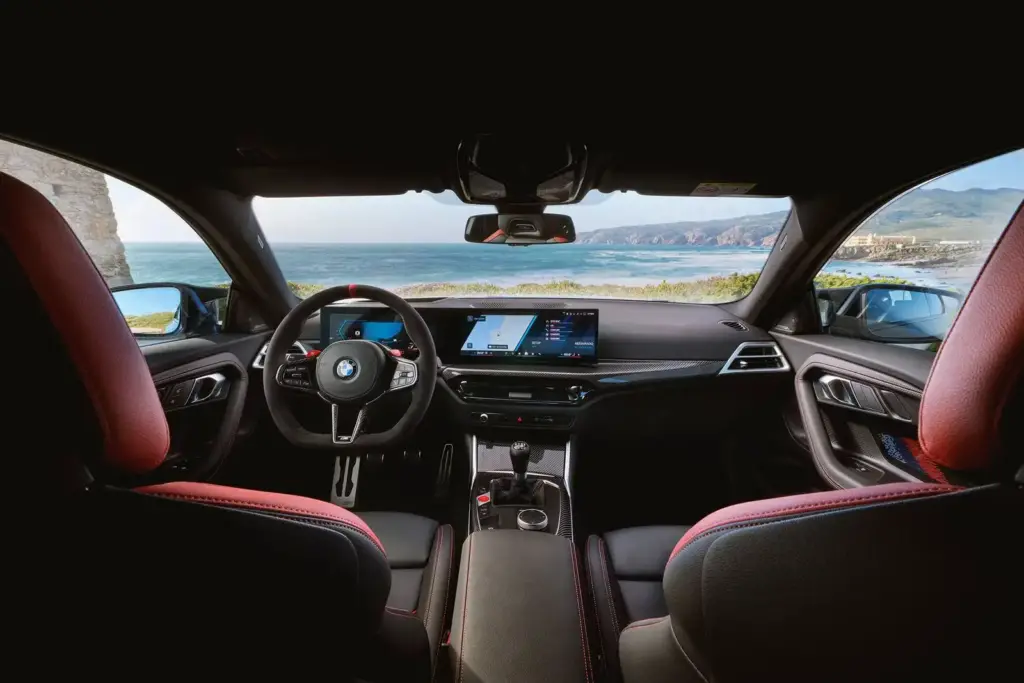
2025 BMW M2 Interior and Comfort
Cabin Design and Materials
The M2 interior emphasizes driver focus over luxury, though material quality meets premium expectations[1][4].
Interior highlights:
- M Sport seats: Standard with enhanced bolstering and integrated headrests
- M Carbon bucket seats: Optional lightweight seats with aggressive side support
- Steering wheel: Flat-bottom design with alcantara grip sections and red center marker
- Materials: Carbon fiber trim, brushed aluminum accents, soft-touch surfaces
- Build quality: Solid construction with consistent panel gaps
- Driver orientation: Controls and displays angled toward driver[1][4]
The M Carbon bucket seats transform track driving experience through enhanced lateral support during aggressive cornering. These fixed-back seats reduce weight while securing occupants firmly in position. However, they sacrifice adjustability and comfort for extended highway trips—buyers should test both seat options before committing to carbon buckets as this decision significantly impacts daily usability[4].
Space and Practicality Concerns
Compact coupe dimensions create predictable space limitations that buyers must assess against actual usage patterns[1][6].
Interior space measurements:
- Front headroom: 38.9 inches (adequate for 6’2″ drivers)
- Front legroom: 42.2 inches
- Rear headroom: 35.6 inches (tight for adults)
- Rear legroom: 30.9 inches (occasional use only)
- Trunk capacity: 15 cubic feet (390 liters)
- Rear seats: 50/50 split-folding for cargo flexibility[1]
The M2 functions best as 2+2 configuration rather than true four-seater. Rear accommodations suit children or brief adult transport but lack comfort for extended journeys. Taller drivers may find front cabin confining despite adequate measurements—the low roofline and rising beltline create cocooned sensation some appreciate for sports car character while others find claustrophobic[6].
Seating Position and Ergonomics
Driver interface design prioritizes performance driving while maintaining daily usability[4].
Ergonomic strengths:
- Driving position: Low, sporty with excellent pedal alignment
- Visibility: Good outward sightlines for sports coupe segment
- Control placement: Intuitive layout for frequently-accessed functions
- Gauge cluster: M-specific displays with performance data
- Storage solutions: Cup holders, door pockets, center console bin adequate for essentials
The flat-bottom steering wheel provides thigh clearance during spirited driving while maintaining comfortable highway cruising position. M1 and M2 buttons on the steering wheel provide instant access to driver-configured vehicle setups—one button press transforms suspension, steering, throttle, and stability settings from comfort to track mode[4].
Interior Color Schemes and Options
BMW offers limited but purposeful interior customization focusing on performance aesthetics[1].
Interior schemes:
- Black: Standard all-black leather with contrast stitching
- Black with Red Highlight: Black base with red accent stitching throughout cabin
- Black with M Color Highlight: Black base with blue/purple/red M tricolor striping
- Alcantara: Steering wheel and shift boot material (standard)
- Carbon fiber trim: Interior package adding visual drama and weight savings
The limited color palette reflects M car philosophy prioritizing function over fashion. Buyers seeking extensive personalization may find options restrictive compared to luxury competitors, though this focused approach reduces decision paralysis and maintains performance-oriented character[1].
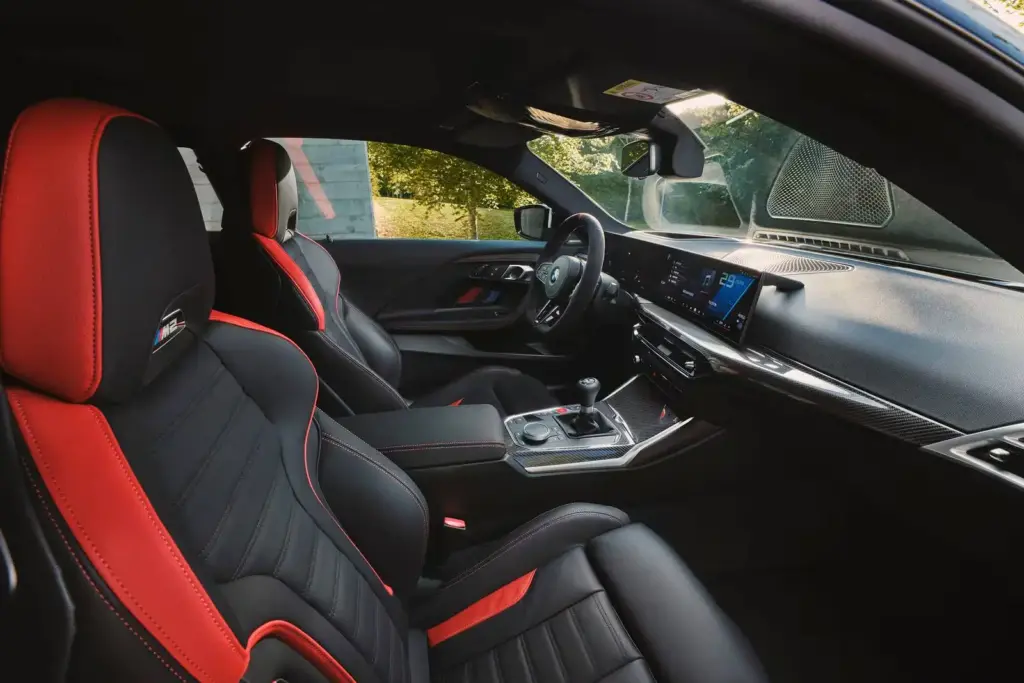
2025 BMW M2 Technology and Features
iDrive 8.5 Infotainment System
The latest iDrive iteration improves responsiveness and interface logic while maintaining BMW’s characteristic learning curve[1][4].
Technology features:
- Instrument cluster: 12.3-inch fully digital driver display
- Touchscreen: 14.9-inch curved OLED with haptic feedback
- Operating system: iDrive 8.5 with improved processing speed
- Wireless connectivity: Apple CarPlay and Android Auto without cables
- Voice control: BMW Intelligent Personal Assistant with natural language
- Navigation: Cloud-based routing with real-time traffic integration
- Over-the-air updates: Remote software updates adding features post-purchase[1][4]
The iDrive 8.5 system represents meaningful improvement over iDrive 7, particularly in response speed and graphics quality. However, the touch-focused interface removes physical controls for climate and volume that many drivers preferred. Voice control partially addresses this concern, though ambient noise sometimes interferes with recognition accuracy during spirited driving[4].
Driver Assistance and Safety Technology
Modern safety systems balance driver engagement with accident prevention[1].
Standard and optional safety features:
- Active Driving Assistant: Lane departure warning, frontal collision warning with braking
- Adaptive cruise control: Stop-and-go capability in traffic (optional)
- Lane keeping assist: Active steering intervention maintaining lane position
- Blind spot monitoring: Visual and haptic warnings for adjacent vehicles
- Parking sensors: Front and rear obstacle detection
- Rearview camera: Standard rear visibility enhancement
- Surround-view camera: 360-degree bird’s-eye parking view (optional)[1]
NHTSA and IIHS have not yet crash-tested the 2025 M2 specifically, though previous generation M2 models achieved strong safety ratings despite performance-focused engineering. The comprehensive airbag system and rigid body structure provide occupant protection meeting current federal safety standards[1].
Audio and Convenience Features
Luxury amenities enhance daily usability without compromising performance character[1].
Convenience equipment:
- Harman Kardon audio: 12-speaker premium sound system (optional, $850)
- Comfort Access: Keyless entry and push-button start (optional)
- Remote engine start: Pre-condition cabin temperature before entry
- Heated elements: Front seats and steering wheel (optional)
- Wireless charging: Inductive phone charging pad in console
- Ambient lighting: Customizable LED cabin illumination with multiple color themes
The standard audio system provides adequate quality for most listeners, though audiophiles appreciate the Harman Kardon upgrade’s improved clarity and bass response. The premium audio investment proves worthwhile for buyers who frequently enjoy music during drives[1].
M-Specific Performance Technology
BMW M division technology enables precise vehicle control and performance optimization[1][4].
M performance systems:
- M Drive modes: Configurable settings for engine, transmission, suspension, steering
- M buttons: Steering wheel shortcuts (M1, M2) to saved configurations
- Launch control: Optimized start procedure for maximum acceleration
- Active M Differential: Electronic limited-slip rear differential
- M Dynamic Mode (MDM): Intermediate stability control level allowing controlled slides
- Performance data recorder: Optional lap timer and telemetry logging
The M1 and M2 buttons revolutionize drive mode accessibility. Rather than navigating menu systems mid-drive, single button press recalls complete vehicle setups encompassing all adjustable parameters. This enables instant transformation from compliant commuter to track-focused weapon without removing hands from steering wheel[4].
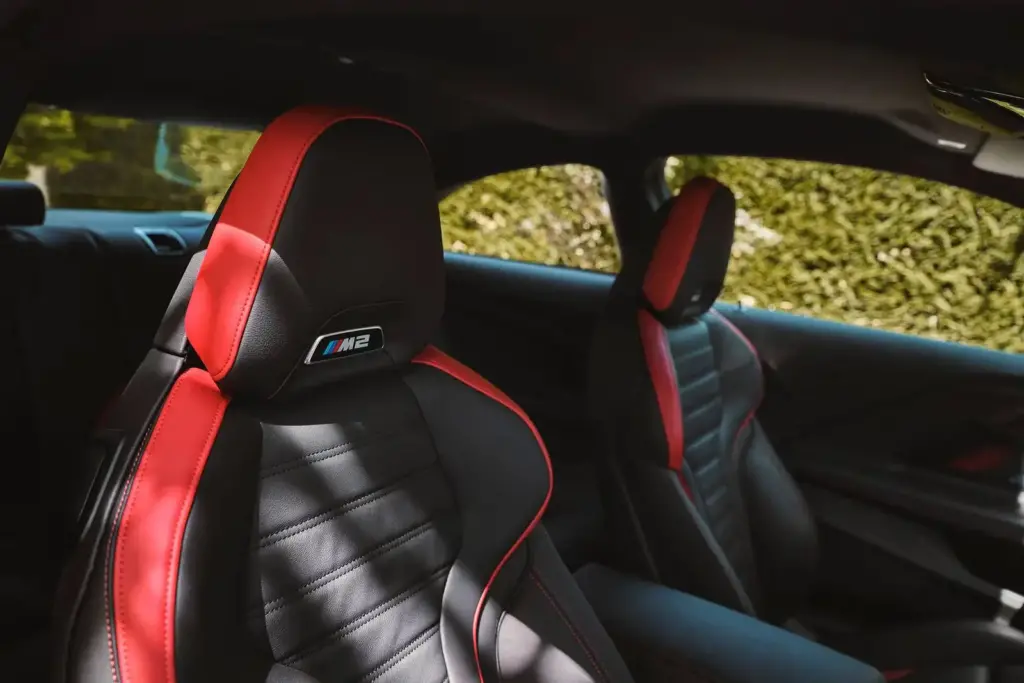
2025 BMW M2 Trim Levels and Packages
Standard M2 Equipment
The base M2 includes comprehensive equipment justifying its $66,675 starting price without requiring expensive option packages[1].
Standard equipment:
- Powertrain: 473 hp S58 twin-turbo engine, choice of manual or automatic
- Wheels: 19-inch M light alloy with Michelin Pilot Sport 4S tires
- Seats: M Sport seats with power adjustment and memory
- Technology: iDrive 8.5, 14.9-inch touchscreen, wireless smartphone integration
- Lighting: LED headlights and taillights with signature BMW light design
- Braking: M Sport brakes with blue-painted calipers
- Differential: Active M limited-slip rear differential
- Exhaust: M Sport exhaust with quad tips[1]
Unlike some competitors that require expensive packages for basic performance hardware, BMW includes core M technologies standard. The Active M Differential, adaptive suspension, and M-tuned braking system come with every M2, ensuring fundamental performance capability without option-creep inflating final pricing[1].
Carbon Package ($9,900)
The Carbon Package represents best-value performance upgrade, bundling weight-saving components with M Driver’s Package[1].
Carbon Package contents:
- Carbon fiber roof: Lightweight panel reducing weight and lowering center of gravity
- M Carbon bucket seats: Lightweight fixed-back performance seats
- Interior trim: Carbon fiber dashboard and door panel accents
- M Driver’s Package: Raised 177 mph top speed and BMW Performance Center driving instruction (included)
- Weight savings: Approximately 40-50 lbs total reduction
- Value proposition: $9,900 for components worth $13,000+ individually[1]
The Carbon Package’s value becomes apparent when pricing components separately. M Carbon bucket seats alone cost approximately $2,500, the carbon roof adds $3,000, and M Driver’s Package runs $2,500—totaling around $8,000 before interior trim pieces. The package pricing represents modest premium for comprehensive weight-reduction and performance enhancement[1].
Additional Option Packages
Supplementary packages address specific buyer priorities beyond core performance[1].
Key option packages:
- M Driver’s Package ($2,500 standalone): Raised 177 mph top speed limiter, BMW Performance Center instruction
- Lighting Package ($650): Adaptive LED headlights with matrix beam technology
- Executive Package: Harman Kardon audio, Comfort Access, heated seats/wheel, gesture control
- BMW Individual colors: Premium paint finishes adding $2,000-$5,000
- M carbon ceramic brakes ($8,500): Fade-resistant braking for track use
- Track Package: Enhanced cooling, performance tires, data logging[1]
The M carbon ceramic brakes deserve careful consideration. While they provide fade-resistant performance during track sessions and reduce unsprung weight, replacement costs reach $12,000-$15,000 for complete rotor and pad service. Buyers planning occasional track days function adequately with standard steel brakes requiring only routine pad and rotor replacements every 30,000-50,000 miles[1].
Build and Price Considerations
Strategic option selection balances capability, comfort, and value[1].
Recommended configurations:
- Value build: Base M2 manual, Lighting Package, Executive Package = ~$72,000
- Track build: Base M2 automatic, Carbon Package, Track Package = ~$80,000
- Ultimate build: M2 with Carbon Package, ceramic brakes, Individual color = ~$95,000
Manual transmission selection saves $1,175 compared to automatic pricing—essentially a no-cost option that adds resale appeal among enthusiasts. Dealer markups remain uncommon on 2025 models given healthy production volumes, allowing modest negotiation leverage of $500-$1,500 off MSRP at motivated dealers. Understanding the car buying process timeline helps buyers navigate M2 acquisition efficiently[1].
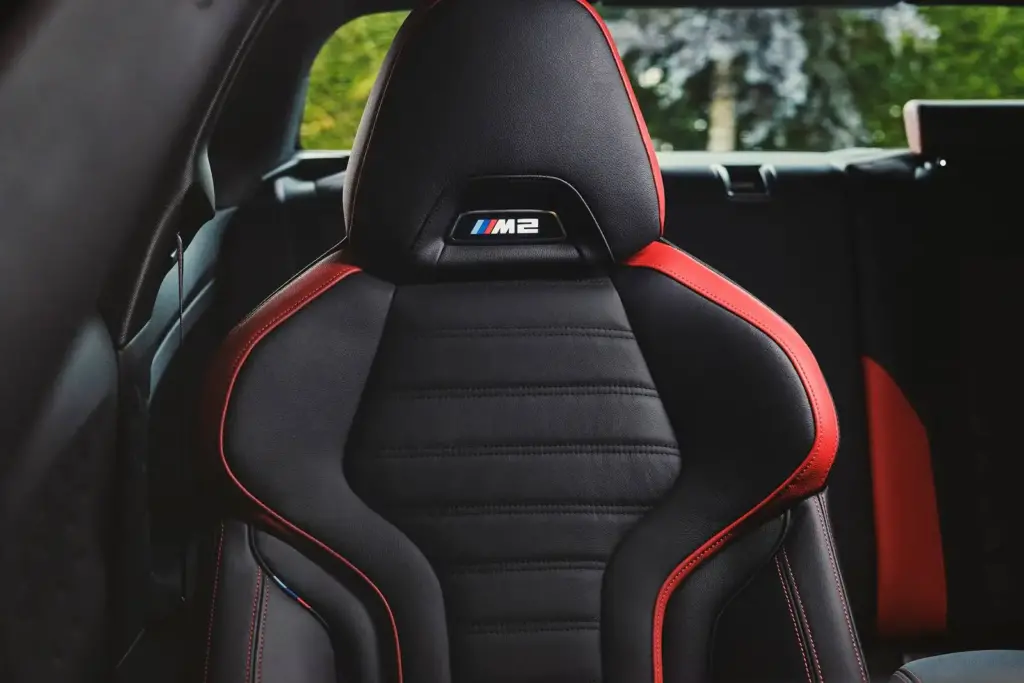
2025 BMW M2 Pricing and Value
MSRP and Pricing Structure
The M2’s pricing positions it competitively within the performance coupe segment[1][2].
2025 M2 pricing:
- Base MSRP: $65,500
- Destination charge: $1,175
- Total starting price: $66,675
- Manual transmission: No additional cost
- Automatic transmission: Included at base price
- Average transaction price: $66,700-$67,000
- Well-equipped pricing: $75,000-$85,000 with popular options[1][2]
The M2 delivers exceptional value in raw performance-per-dollar metrics. At $66,675, it costs less than a base Porsche 718 Cayman ($72,800) while offering 173 additional horsepower (473 hp versus 300 hp). Among rear-wheel-drive performance coupes with 450+ horsepower, only the Chevrolet Corvette C8 approaches similar pricing around $68,000[1].
Comparison to Previous Model Years
The 2025 price increase remains modest relative to added performance and technology[1].
Year-over-year pricing:
- 2024 M2 base: $65,500
- 2025 M2 base: $65,500 (unchanged)
- 2024 destination: $1,095
- 2025 destination: $1,175 (+$80)
- Effective increase: $80 (0.1%)
- Power gain: +20 hp (+4.4%)
- Value improvement: More power for effectively same price[1]
Inflation-adjusted analysis reveals the 2025 M2 represents better value than 2024 despite nominal price stability. With general inflation running 3-4% annually, the sub-1% price increase combined with power gain creates genuine value improvement. BMW absorbed most cost increases rather than passing them entirely to consumers[1].
Cost of Ownership Analysis
Total ownership costs extend beyond purchase price into insurance, maintenance, fuel, and depreciation[1][7].
Annual ownership cost estimates (15,000 miles):
| Expense Category | Annual Cost | Notes |
|---|---|---|
| Insurance | $2,500-$4,000 | Varies by age, location, driving record |
| Maintenance | $1,500-$2,500 | Oil changes, inspections, wear items |
| Fuel | $2,900 | Premium @ $4.50/gal, 19 mpg combined |
| Registration/taxes | $800-$2,000 | State-dependent fees |
| Depreciation | $8,000-$12,000 | ~40% over 5 years |
| Total annual | $15,700-$23,400 | First-year ownership cost |
Five-year depreciation averages 40% for M2 models based on F87 generation data, though manual transmission variants may depreciate slower given increasing rarity. The previous generation M2 Competition manual holds value better than automatic equivalents—enthusiast demand for three-pedal M cars supports stronger residual values[7].
Financing and Lease Options
Financial structuring impacts monthly payments and total ownership cost[1].
Estimated financing (September 2025, excellent credit):
- 60-month loan (20% down): ~$1,250/month @ 6.5% APR
- 48-month loan (20% down): ~$1,450/month @ 6.5% APR
- 36-month lease: ~$900/month with $5,000 down, 10,000 miles/year
- 48-month lease: ~$800/month with $5,000 down, 10,000 miles/year
Leasing makes limited sense for M2 given strong residual values and enthusiast collector appeal. Buyers planning 3-year ownership should purchase rather than lease, particularly manual transmission variants likely commanding premium pricing in used markets. The BMW M2 maintains stronger residual values than most performance cars[1].
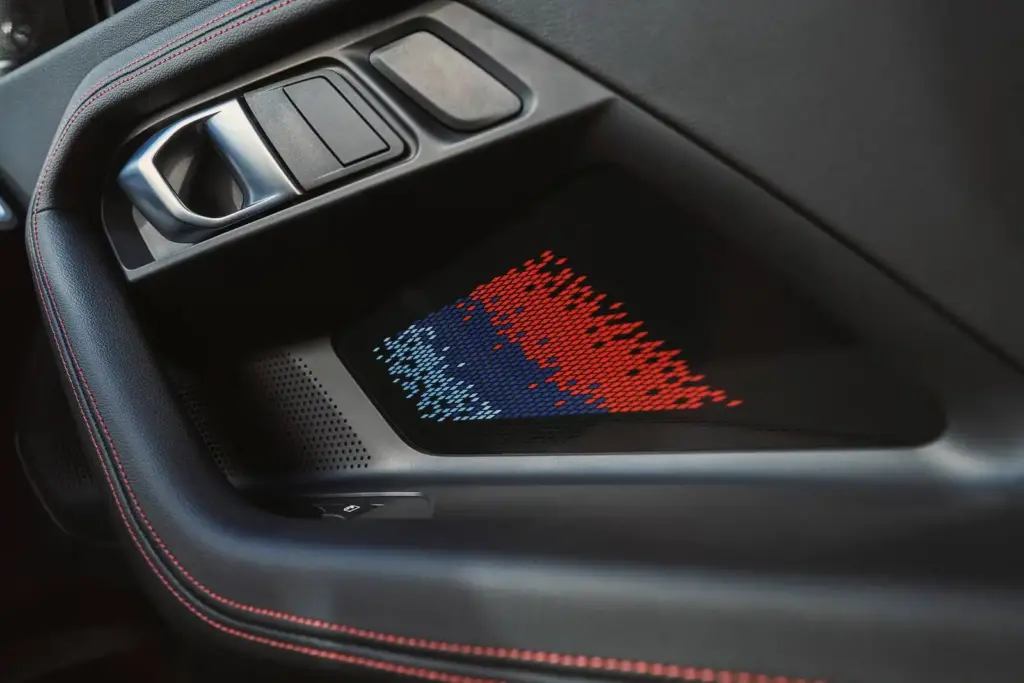
2025 BMW M2 vs. Key Competitors
BMW M2 vs. BMW M4
The intra-brand comparison helps buyers determine whether the compact M2 or larger M4 better suits their needs[1][8].
| Specification | M2 | M4 Competition |
|---|---|---|
| Power | 473 hp | 503 hp |
| 0-60 mph | 3.9 sec | 3.4 sec |
| Price | $66,675 | $87,000+ |
| Wheelbase | 108.1″ | 112.8″ |
| Weight | ~3,800 lbs | ~4,000 lbs |
| Manual option | Yes | No (US market) |
| Rear seats | Limited | More spacious |
The M2 represents “right-sizing” philosophy—compact dimensions create nimble character impossible in larger platforms. The M4’s 30 additional horsepower and larger footprint deliver superior straight-line performance and interior space, but the M2 feels more engaging through technical roads where agility matters more than power. The $20,000 price difference favors M2 for buyers prioritizing value over ultimate performance[8].
BMW M2 vs. Porsche 718 Cayman
This cross-brand rivalry represents front-engine versus mid-engine layout philosophy[1].
Performance and practicality comparison:
- M2: 473 hp, $66,675, front-engine RWD, rear seats, larger trunk
- Cayman base: 300 hp, $72,800, mid-engine RWD, two-seater only
- Cayman GTS: 400 hp, $90,300, mid-engine handling purity
- Cayman GT4: 414 hp, $101,300, track-focused hardcore variant
The Cayman’s mid-engine layout provides inherently better weight distribution (45/55 versus M2’s 50/50) creating sharper turn-in and balance. However, the base Cayman costs $6,125 more than M2 while delivering 173 fewer horsepower—positioning strongly favoring BMW. The M2 counters Cayman’s chassis advantages with more power, rear seats, and larger trunk. Buyers prioritizing pure driving experience lean Cayman; those wanting performance with practicality choose M2[1].
BMW M2 vs. Toyota GR Supra
Platform-sharing creates interesting comparison between German and Japanese sports coupes[1].
Supra relationship:
- Shared platform: Both use BMW CLAR architecture
- Engine family: Related BMW inline-six engines (B58 in Supra, S58 in M2)
- M2 advantages: 91 additional hp (473 vs 382), manual transmission option, rear seats
- Supra advantages: $10,000-$11,000 lower pricing, Toyota reliability reputation
- Styling differentiation: Distinct aesthetics despite platform commonality
The Supra delivers approximately 85% of M2 performance for $10,000 less while providing Toyota’s legendary reliability. The M2 justifies its premium through additional power, manual transmission availability, and rear seats. Both share BMW engineering DNA, though the M2 receives more performance-focused calibration throughout chassis and powertrain systems[1].
BMW M2 vs. Chevrolet Corvette C8
American versus German performance philosophies clash at identical price points[1].
Corvette comparison:
- Price parity: Both start around $67,000-$68,000
- M2 character: Front-engine, practical daily driver, rear seats, trunk space
- Corvette character: Mid-engine, exotic presence, 495 hp, minimal storage
- Attention factor: Corvette draws significantly more public interest
- Daily usability: M2 superior for commuting and errands
The Corvette’s mid-engine layout and dramatic styling create supercar experience at mainstream pricing. The M2 prioritizes daily usability with compliant ride quality, rear seats, and reasonable trunk capacity. Track capability largely matches despite different approaches—the M2 via chassis balance, the Corvette through mid-engine physics. Buyers seeking exotic experience choose Corvette; those wanting performance with practicality select M2[1].
BMW M2 vs. Audi RS 3
The rear-drive M2 coupe confronts all-wheel-drive Audi sedan in performance compact comparison[1].
RS 3 matchup:
- M2: Rear-wheel drive coupe, 473 hp, manual option, two-door practicality
- RS 3: All-wheel drive sedan, 401 hp, automatic-only, four-door utility
- M2 engagement: RWD dynamics, manual transmission, pure driving focus
- RS 3 versatility: AWD all-weather capability, sedan practicality, broader usability
- Pricing: Similar mid-$60K range
The RS 3 provides all-weather capability and sedan practicality but lacks manual transmission and RWD driving character. The M2 offers more engaging dynamics for enthusiasts prioritizing driving experience, while the RS 3 suits buyers wanting performance with year-round utility. Neither choice proves wrong—individual priorities determine best fit[1].
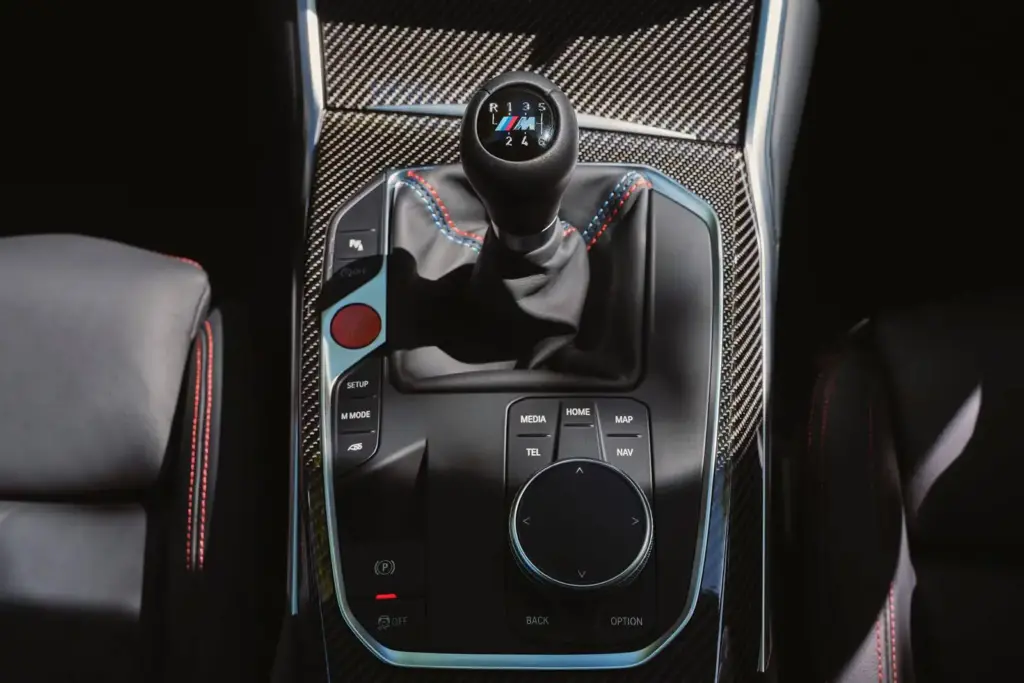
2025 BMW M2 Pros and Cons
What Reviewers and Owners Love
The M2 earns consistent praise for specific attributes that define its character[4][6].
Strengths and highlights:
- Powerful engine: Turbocharged inline-six delivers eager, responsive power across rpm range
- Tenacious handling: Confidence-inspiring grip and cornering capability
- Manual transmission: Rare three-pedal option provides authentic engagement
- Weight distribution: Perfect 50:50 balance creates neutral, predictable dynamics
- Driving position: Excellent ergonomics and outward visibility
- Technology integration: iDrive 8.5 responsive with intuitive smartphone connectivity
- Value proposition: Competitive pricing for performance delivered
- Nimble character: Compact dimensions create agility larger cars cannot match[4][6]
According to Autvex automotive analysis, the M2’s greatest strength lies in its cohesive package rather than any single standout feature. The combination of adequate power, balanced chassis, manual transmission option, and compact dimensions creates driving experience greater than sum of individual components.
What Reviewers and Owners Criticize
Honest assessment requires acknowledging legitimate shortcomings alongside strengths[4][6].
Common criticisms:
- Tight interior: Cramped rear seats unsuitable for adult passengers regularly
- Firm ride: Harsh suspension at low speeds transmits road imperfections
- Road noise: Noticeable tire roar during highway cruising
- Steering feel: Electric power steering lacks tactile feedback and communication
- Variable-ratio steering: Speed-sensitive ratio not universally appreciated
- Polarizing styling: “Pugnacious” wide-body appearance divides opinions
- Daily comfort: Firm dampers and road noise affect long-distance usability[4][6]
The steering criticism appears most frequently in reviews. While the chassis provides excellent grip and balance, the speed-sensitive electric power steering feels disconnected, requiring trust in front-end capability rather than tactile communication through rim. This forces drivers to lean on available grip through faith rather than feedback—effective but less satisfying than hydraulic steering in previous M cars[6].
Common Reliability Concerns
The S58 engine shows strong reliability with proper maintenance, though certain issues appear across the platform[7].
Known issues and concerns:
- Rear taillights: Indicator malfunctions requiring replacement (known defect)
- Cooling system: Water pump, thermostat, and radiator component failures
- Electrical glitches: Occasional infotainment freezing or sensor faults
- Differential concerns: Early production units experienced limited-slip issues
- Overall reliability: S58 significantly more reliable than previous N54/N55/S55 engines
The S58’s closed-deck design and forged internals provide structural strength supporting high-performance use without durability concerns affecting earlier BMW turbo engines. Regular maintenance following BMW’s recommended service intervals prevents most potential problems. The rear taillight issue represents manufacturing defect rather than design flaw—BMW covers replacements under warranty[7].
Long-Term Ownership Considerations
Five-year ownership reveals costs and concerns beyond initial purchase[1][7].
Long-term factors:
- Maintenance costs: $1,500-$2,500 annually for normal driving
- Premium fuel: Ongoing $2,900 annual expense (15,000 miles)
- Carbon ceramic brakes: $12,000-$15,000 replacement if equipped
- Suspension wear: Control arm bushings, end links require replacement 60,000-80,000 miles
- Manual transmission value: May command resale premium as rarity increases
- Enthusiast demand: Strong collector interest supports residual values
Manual transmission M2s likely depreciate slower than automatic equivalents given increasing rarity. As BMW and other manufacturers abandon manual options, three-pedal cars acquire collector appeal beyond their original market positioning. The F87 M2 Competition manual currently trades at or above original MSRP in pristine condition—unusual for non-exotic performance cars[7].
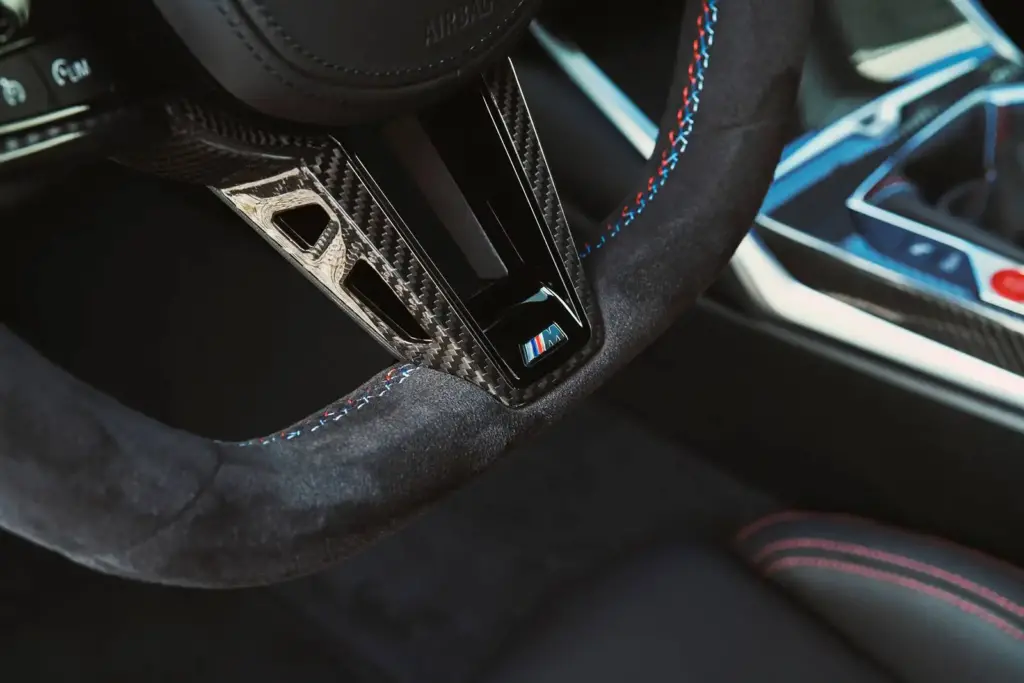
Should You Buy the 2025 BMW M2?
Who Should Buy the M2
The M2 excels for specific buyer profiles prioritizing engagement over ultimate comfort[3][4].
Ideal M2 buyers:
- Manual enthusiasts: Last opportunity for new three-pedal M car
- Driving engagement priority: Those valuing involvement over absolute comfort
- Track day participants: Weekend circuit use requiring street-legal performance
- Compact sports coupe seekers: Wanting nimble handling over straight-line speed
- Value-focused buyers: Avoiding M3/M4 premium pricing
- Collector-minded enthusiasts: Recognizing historical significance of final manual M car
The manual M2 represents potentially final chance to purchase new BMW M car with three pedals. BMW executives confirmed manual availability continues only while demand justifies production costs. With global manual take rates around 10-30% depending on market, this option faces uncertain future. Enthusiasts wanting manual M car should act rather than waiting—this opportunity may not return[3].
Who Should Consider Alternatives
The M2 doesn’t suit all buyers despite exceptional performance[1][6].
Consider alternatives if:
- Space requirements: Needing adult rear passenger accommodation regularly
- Ride comfort priority: Sensitive to firm suspension and road noise
- Highway commuting: Daily long-distance driving with comfort emphasis
- Steering feedback importance: Desiring hydraulic steering communication
- Styling preferences: Finding M2’s aggressive appearance too polarizing
- All-weather capability: Requiring all-wheel drive for winter conditions
Buyers prioritizing ride comfort for daily commuting should honestly assess whether M2’s firm suspension and road noise suit their tolerance. The Sport and Sport Plus damper settings prove too stiff for public roads, while even Comfort mode transmits more harshness than luxury competitors. Test drives on representative road surfaces reveal whether this trade-off proves acceptable[6].
Manual or Automatic Transmission?
The transmission decision carries implications beyond performance metrics[3][5].
Manual transmission considerations:
- Choose manual for: Maximum engagement, purist appeal, collector value potential
- Accept: 0.4-second slower 0-60 mph, 36 lb-ft less torque, heavier clutch effort in traffic
- Gain: Authentic driving involvement, rev-matching capability, lighter weight
- Long-term: Potential resale premium as manual M cars become extinct
Automatic transmission considerations:
- Choose automatic for: Faster acceleration, convenience, optimal track times
- Accept: Less driver involvement, no three-pedal experience
- Gain: 442 lb-ft torque advantage, smoother shifts, adaptive cruise compatibility
- Long-term: Broader buyer appeal may offset manual collector premium
The manual choice requires accepting performance compromises for intangible benefits. The 0.4-second 0-60 mph penalty matters less than the engagement three pedals provide. Buyers should test both transmissions during representative driving—city traffic, highway cruising, and spirited back roads—before committing to this irreversible decision[5].
Best Time to Buy and Negotiation Tips
Strategic timing and negotiation maximize value when purchasing performance cars[1].
Buying strategy:
- Current availability: Good dealer inventory throughout U.S.
- Negotiation leverage: Modest discounts possible ($500-$1,500 off MSRP)
- End-of-year timing: September-November traditionally offers best deals
- Model year transition: 2026 M2 CS launch may improve 2025 base M2 negotiation
- Manual transmission: May sell faster given enthusiast demand
- Color selection: Popular M-specific colors retain value better
The 2025 M2’s healthy production volumes eliminate dealer markup concerns common on limited-production vehicles. Multiple dealers competing for business creates negotiation opportunity, particularly as 2026 model year approaches. Buyers should obtain quotes from several dealers, leveraging competing offers to secure favorable pricing. Understanding the car buying process timeline helps navigate M2 acquisition efficiently[1].
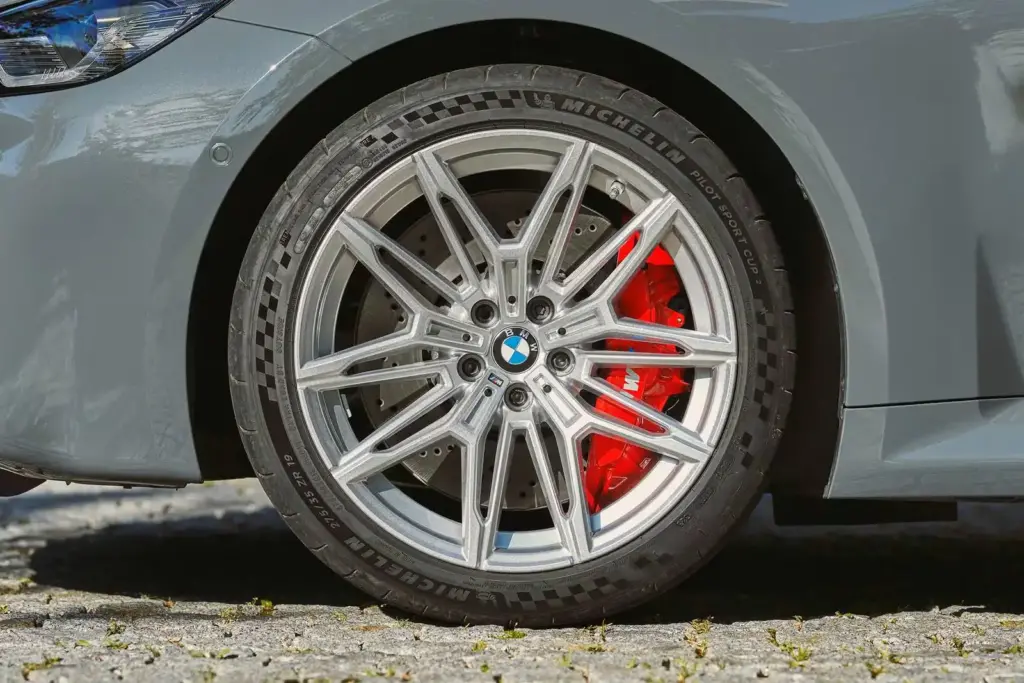
Key Takeaways
- The 2025 M2 delivers 473 hp for $66,675, offering exceptional performance-per-dollar value in sports coupe segment.
- Manual transmission represents likely final opportunity for three-pedal BMW M car before permanent extinction from lineup.
- Interior space limitations and firm ride quality affect daily usability; test drive on representative roads before purchasing.
- S58 engine shows strong reliability; expect $1,500-$2,500 annual maintenance costs with proper service schedule adherence.
- Manual transmission likely commands future resale premium as rarity increases; consider collector value potential when choosing.
- Carbon Package provides best-value upgrade at $9,900; includes roof, bucket seats, and M Driver’s Package worth $13,000+ separately.
- Steering feel lacks tactile feedback common in hydraulic systems; requires trust in chassis grip rather than rim communication.
FAQs
Is the 2025 BMW M2 reliable?
The S58 engine shows strong reliability with proper maintenance, significantly outperforming previous BMW M engines. Common issues include rear taillight malfunctions and occasional cooling system components. Annual maintenance costs average $1,500-$2,500[7].
What’s the difference between manual and automatic M2?
How much does the 2025 BMW M2 cost?
Is the BMW M2 good for daily driving?
What is the 0-60 time for the 2025 BMW M2?
Does the 2025 BMW M2 have rear seats?
Yes, the M2 includes rear seats with 30.9 inches legroom—adequate for children or occasional adult use but cramped for regular rear passenger transport. The M2 functions best as 2+2 configuration rather than true four-seater[1].
How does the M2 compare to the M4?
M2 offers 473 hp for $66,675 with compact, nimble handling and manual transmission option. M4 provides 503 hp for $87,000+ with larger dimensions, more interior space, but automatic-only transmission. M2 delivers better value; M4 offers more prestige and power[8].
What are common problems with the BMW M2?
Most frequent issues include rear taillight/indicator malfunctions (known defect), cooling system component failures (water pump, thermostat), and occasional infotainment electrical glitches. The S58 engine proves generally reliable with proper maintenance[7].
Is the BMW M2 worth buying over a Porsche Cayman?
Depends on priorities. M2 offers 173 more horsepower (473 vs 300 base Cayman), costs $6,125 less, and includes rear seats. Cayman provides mid-engine handling purity, better steering feel, and superior chassis balance. Choose M2 for power/practicality, Cayman for driving purity[1].
Will the BMW M2 hold its value?
Manual transmission M2s likely depreciate slower than automatics given increasing rarity. Average depreciation runs ~40% over 5 years for automatic M2s. Manual variants may command premiums in used market as final three-pedal M car gains collector appeal[7].
References
- Car and Driver. (2024). 2025 BMW M2 Review, Pricing, and Specs. https://www.caranddriver.com/bmw/m2
- Driving.ca. (2025). Car Review: 2025 BMW M2. https://driving.ca/reviews/road-test/car-review-2025-bmw-m2
- Automotive Addiction. (2025). The Last Manual BMW We Will See: G87 BMW M2. https://www.automotiveaddiction.co.uk/2025/06/30/the-last-of-its-kind-saying-goodbye-to-the-manual-with-the-g87-bmw-m2/
- BMW Blog. (2025). 2025 BMW M2 Review and Driving Experience. https://www.bmwblog.com/2025/02/12/2025-bmw-m2-manual-review/
- Edmunds. (2025). Tested: Is the BMW M2 Better With a Manual or Automatic? https://www.edmunds.com/car-news/2025-bmw-m2-manual-automatic-tested.html
- Evo. (2025). BMW M2 2025 review – a fun, full-fat M car but no slouch. https://www.evo.co.uk/bmw/m2
- Reddit. (2024). M2 Reliability Discussion. https://www.reddit.com/r/BMW/comments/1b02net/m2_reliability/
- CarBuzz. (2025). BMW M2 vs. M4: Comparing Two Sporty Siblings. https://carbuzz.com/comparison-bmw-m2-m4-coupe/

I am a senior automotive analyst at Autvex. Expert vehicle evaluations, in-depth reviews, and objective analysis helping readers make informed automotive decisions with years of industry experience.




